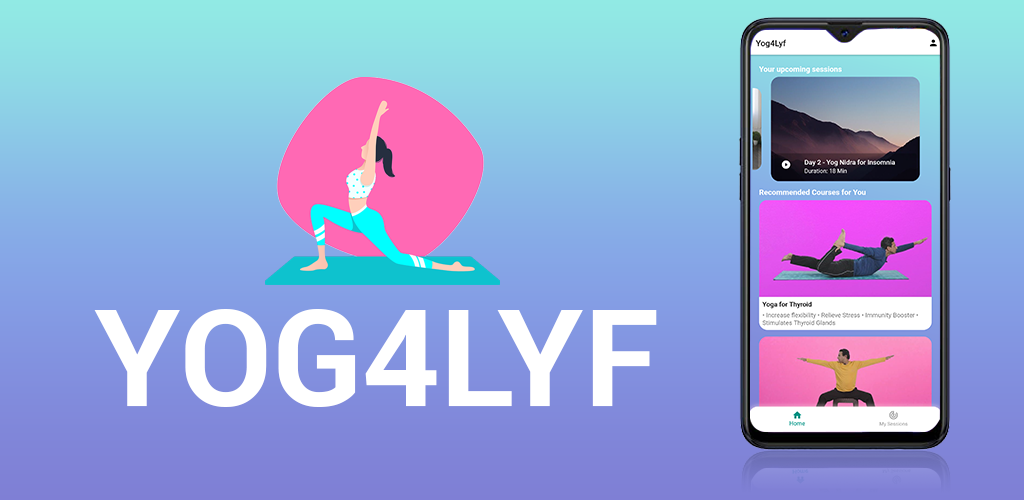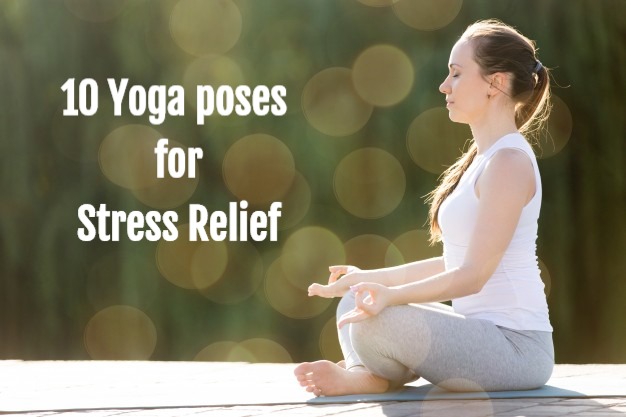Hello and welcome to Yog4lyf, your one-stop solution for your entire Yoga dose. So today we will be discussing Sinusitis, also referred to as Sinus, and how the practice of yoga asanas along with some breathing exercises can help you cure sinusitis. Before we indulge in the significance of yoga in the process of curing Sinus, let’s take a look at what exactly is Sinusitis.
What is Sinusitis?
Medically known as rhinosinusitis, in simple terms; a sinus is a hollow space or cavity in the body. It is the result of inflammation of the air cavities within the passages of the nose. The lining of these sinuses has the same composition as the lining of your nose. It is covered in mucous, a transparent fluid that protects the body against bacteria, viruses, and germs. This mucous keeps the nasal passage moist. Now when bacteria or allergens trapped in the nasal cavity leads to mucous accumulation which in turn blocks the sinus openings. The excess mucous build-up will encourage bacteria in the sinus cavity causing inflammation and leaves you with excessive unbearable pain.
But worry not, after leaning yoga poses and pranayama to cure sinusitis you will be confident that this menace will not flock around you and your family.

Also, check out our previous posts on yoga to cure hair loss and hypertension:
- Yoga to cure hair loss – https://www.yog4lyf.com/post/yoga-asanas-to-cure-hair-loss
- Yoga for Hypertension – https://www.yog4lyf.com/post/hypertension-in-control-through-yoga
What Causes Sinusitis?
Usually, when the tissue in your nose gets swollen due to an allergy or cold, flu, or viral infection, it can block the sinus passages. When your sinuses cannot drain, you end up with excessive pain. Most cases are caused by viral infections and cured within a few days. However, in a few cases, a bacterial infection develops due to a lack of oxygen in the sinus. If the body’s natural defenses are not working properly, the bacteria can cause infection. In other cases, smoking, alcohol consumption, and a stressful life also plays a major role in a sinus infection.
Sub categories of Sinusitis
Acute Sinusitis is a short-term inflammation triggered by cold or allergies and it is usually resolved on its own in a couple of days.
Whereas Chronic Sinusitis occurs when spaces inside your nose and head remain swollen for 8-10 weeks.
How do the symptoms of sinus look like?

- Fever
- Headaches
- Sore throat
- Cough
- Thick nasal discharge which may be yellow or green
- Blocked or runny nose
- Reduced sense of smell and taste
- Tenderness and swelling around the eyes, nose, cheeks, and forehead.
Let’s take a look at some mind-blowing statistics about sinusitis:
- According to a survey report by The National Institute of Allergy and Infectious Disease, approximately 135 million people in India (one in eight) suffer from Chronic Sinusitis.
- About 35 million Americans suffer from sinusitis at least once a year.
- Sinusitis complicates 0.5% of upper respiratory tract infections.
- Women tend to have more episodes of infective sinusitis than men. The rate in women is 20.3% compared with 11.5% in men.
- Every year, sinusitis causes approximately 73 million restricted activity days.
- About 47% of cases improve within one week without any antibiotics.
How Yoga helps to cure sinusitis?
You must be wondering can Yoga really help in curing Sinusitis. Is it really effective? The answer is a simple yes. For ages, yoga has been an integral part of the path to a healthy lifestyle. Yoga restores the balance in the body keeping the mind and body fresh.
2 methods in yoga to cure sinusitis
First by balancing the energy centers or nadis in the body, and second, by affecting the deep mental states or obstructions that arise with the symptoms of the disease.
When we talk about Sinusitis, it is crucial to attaining respiratory relief, yoga poses are designed in a way that helps in treating the disorder without any difficulties. It helps you flush the mucous out of the cavities and clears the nasal passage. Yoga therapy can provide a complete cure for sinusitis. Many people have successfully uprooted both chronic and acute sinusitis using yoga therapy.
Yoga poses and pranayama to cure sinusitis
- Alternative nostril breathing | Anulom Vilom
- Bhastrika Pranayama | Breath of fire
- Kapalbhati Pranayama | Skull Shining Breath
- Cobra Pose | Bhujangasana
- Camel Pose | Ushtrasana
- Child Pose | Balasana
- Rabbit Pose | Saasangasana
- Fish Pose | Matsyasana
- Bridge Pose | SetubandhAsana
- Downward Facing Dog Pose | Adho Mukha Svanasana
- Jal Neti | Nasal Irrigation
1. Alternative nostril breathing | Anulom Vilom

Steps:
- Sit comfortably on your mat and sit straight so that your back, neck, and head are aligned.
- Let your left-hand rest on your left knee.
- There is this particular hand pose that one has to perform with his right hand. There is a reference image. You have to curl up your index and middle finger and let the other fingers be open and not curled up.
- Maintaining the same hand pose, use your thumb to press your right nostril and inhale deeply from your left nostril.
- Hold your breath for 5 seconds and then press your left nostril with your ring finger and lift your thumb from your right nostril and exhale slowly.
- Keep repeating this 15-20 times.
Precautions:
- Avoid practicing it if you are suffering from high blood pressure or any heart disease.
2. Bhastrika Pranayama | Breath of fire

Steps:
- Sit comfortably on the mat, and fold your legs.
- Sit straight and keep your back neck and head aligned.
- Bend your elbows, placing them in front of your torso.
- When you inhale, move your elbows up and palm open and placing it near your ears.
- Hold your breath for 2-3 seconds.
- Then you exhale, and when you exhale, push your breath out and swing your elbows down and your open palm into a fist.
- Keep inhaling and exhaling 20-25 times continuously.
Precautions:
- Avoid practicing Bhastrika Pranayama if you are suffering from high blood pressure.
- A person suffering from acute heart problems should not practice Bhastrika Pranayam.
3. Kapalbhati Pranayama | Skull Shining Breath

Steps:
- Sit comfortably on your mat and sit straight so that your back, neck, and head are aligned.
- Inhale normally and exhale forcefully through your nostrils only.
- Keep inhaling and exhaling in this manner for 30 -50 seconds.
Precautions:
- Avoid Kapalbhati if you are pregnant.
- Avoid if you are suffering from high blood pressure or heart-related discomforts
- Not to be practiced when having an asthma attack.
4. Cobra Pose | Bhujangasana

Steps:
- To begin with, first, lie down flat on your stomach.
- Place your legs comfortably and toes touching the floor and sole facing the roof.
- Then place your palm near your chest,
- Keep your elbows closely tucked inside.
- Then without moving your lower body, raise your upper body supported by your hands.
- Keep breathing normally and stay in the same position for 30 second
- Withdraw from that position, take a rest, and try again for more than 30 seconds.
Precautions:
- Do not practice Cobra pose, if you have any recent back or wrist injury.
- Avoid if you are pregnant.
5. Camel Pose | Ushtrasana

Steps:
- First of all, kneel on the floor.
- Keep your thighs and feet together.
- Toes should be pointing back and resting on the floor.
- Bring the knees and the feet about one foot apart and stand on the knees.
- Inhale, bend backward slowly.
Precautions:
- Avoid this pose if you are suffering from high or low blood pressure.
- Do not practice the camel pose if you have a migraine, serious lower back, or neck injury.
- Avoid it if you are suffering from Insomnia.
6. Child Pose | Balasana
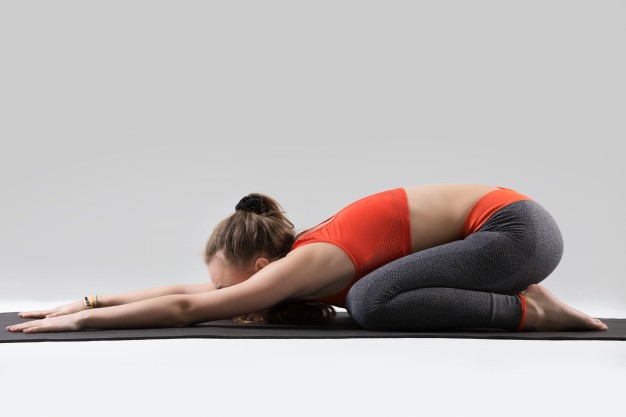
Steps:
- Sit on your knees resting your upper body on the thighs. Your feet should be lying on the floor.
- Make sure to keep your waist straight and maintain a short distance between your knees.
- Inhale and lean your upper body forward and try to rest your forehead on the floor. Use a pillow if you are unable to place your forehead comfortably on the floor.
- Stretch your arms in front of you. Your chest should touch your thighs.
- Try to lengthen your tailbone towards the pelvis.
- Now bring your arms back alongside your thighs, palms facing upwards.
- You are now in Balasana | Child pose, remain in this posture for 30 seconds to 2 minutes, and keep breathing slowly.
- Now to come back to your normal position, bring your palms under the shoulders and slowly raise your upper body. Lift your torso from the tailbone as it presses down and into the pelvis.
Precautions:
- People suffering from Diarrhoea should avoid this asana.
- If you have a knee injury or joint pain, avoid this asana or practice it under expert guidance.
7. Rabbit Pose | Saasangasana
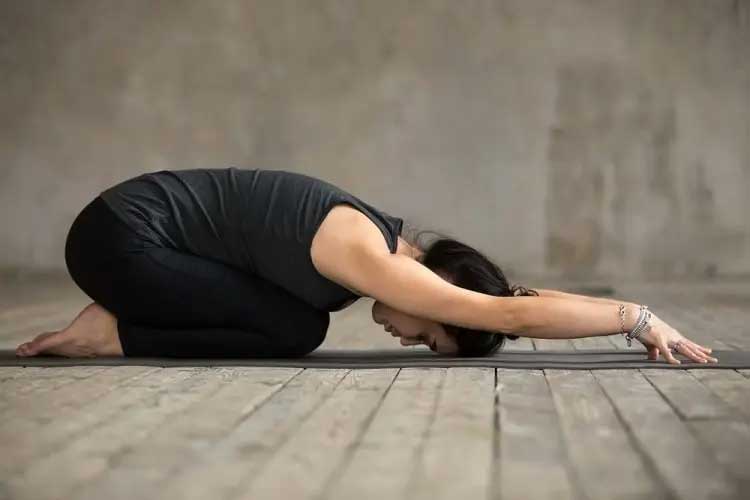
Steps:
- From Child pose, grab your heels with the hands and pull the forehead in towards the knees keeping the top of the head on the floor.
- With a deep inhalation, hold tightly onto the heels and gently lift the hip upwards.
- Roll onto the crown of the head and press the forehead as close to the knees as possible.
- Breathe and hold onto this posture for 5-8 breaths.
- To come out, slowly exhale and lower the hips to the heels and slowly slide the forehead back to the floor into child pose.
Precautions:
- Avoid in case of recent injury in knee, neck, spine, or shoulders.
8. Fish Pose | Matsyasana

Steps:
- Roll up a blanket and then lie down flat on the floor keeping the rolled blanket
- between your shoulders and hips
- Your head should be thrown back and it should touch the floor, hands by your side, palms up, legs straight.
- Breathe in and out gently. If you take 2 seconds to breathe in, take 4 seconds to exhale.
- Practice for 2 minutes to start with. Extend time as you go along.
Precautions:
- Avoid this asana if you are suffering from high blood pressure or low blood pressure.
- Avoid practicing this pose if you have any back or neck injury or hernia.
9. Bridge Pose | SetubandhAsana

Steps:
- Lying on your back, bend both knees and place the feet flat on the floor hip-width apart.
- Place your arms alongside the body with the palms facing down.
- The fingertips should touch the heels.
- Inhale and lift the hips up, by giving a little pressure on the feet towards the floor.
- Lift your chest up with the support of your arms and shoulders.
- Please note that your shoulders and arms should be resting on the floor.
- Breathe and hold for 4-8 breaths.
- To release: exhale and gently place your spine back to the floor.
Precautions:
- Avoid practicing this pose if you are suffering from neck or back pain.
- Avoid the yoga pose if one is having any knee pain.
- Avoid it during a shoulder injury.
- Avoid moving your head left or right.
- Do not put more pressure on the neck.
10. Downward Facing Dog Pose | Adho Mukha Svanasana

Steps:
- Stand straight on your legs then bend forward.
- Place your palms on the floor, note that your fingers are widely spread and balanced.
- There should be enough space between your knees and palm.
- Now, take note that your wrists are exactly aligned with your shoulder, and knees aligned with hips.
- Stretch your elbows and let your upper back relax.
- Lift both your knees from the floor and raise your pelvis too.
- Straighten your legs gradually, as straight as possible.
- Bring your body into the shape of the alphabet ‘A’.
- Stay stable and do not change the distance between your palms and feet.
- Draw your shoulder blades into your upper back ribs and toward your tailbone.
- Hold this position for 30 seconds and later you can increase your time limit.
- To relax from that position, relax your knees and bend down.
Precautions:
- If the person practicing this pose has stiff or weak back muscles, tight hamstrings, sciatica, or knee problems should practice this pose gently and gradually easing in and out of the pose while keeping the knees bent and back straight.
- Those with Carpal Tunnel Syndrome should press down into the base of their fingers.
11. Jal Neti | Nasal Irrigation
Jal Neti or Nasal Irrigation is one of the six body cleansing techniques, also referred to as Shatkarma. Each of these 6 techniques is performed to clean particular parts of the body. Jal Neti focuses on nostrils and areas related to the nasal cavity. The cavities in the sinuses that are blocked with various impurities may often lead to inflammation and headaches. Jal Neti helps in the expulsion of dried mucous from the nose and helps create an unobstructed flow of air. It offers a simple option for keeping the sinuses clean from all such impurities.
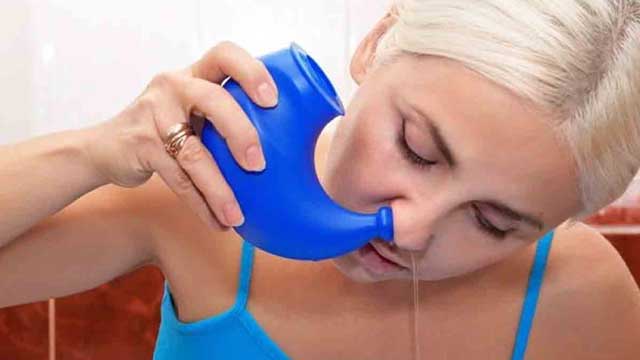
You would need lukewarm water with a pinch of salt and a Neti Pot. Neti pot is similar to a teapot. It is designed in a way that it fits easily in the nostrils.
Steps:
- First of all, be seated comfortably (refer Kagasana) and lean slightly to your front to let the water flow in the right position.
- Keep the neck tilted diagonal and breathe through the mouth. Do not breathe through your nose while performing this activity.
- Place the nozzle of the pot inside the left nostril.
- Tilt your head towards the right and adjust your head in a way that water flows from the left nostril to the right nostril. Keep doing until the pot is empty and clean your nostrils.
- Refill the pot and repeat for another side.
- Once you have finished both the side, do forceful exhalation from both the nostrils to cleanse is thoroughly.
Precautions:
- The nose should be properly dried after the process. Make sure you do not leave any water in the nasal passages as it might cause infection.
Note:
It is highly recommended to perform Jal Neti under supervision, especially for beginners to avoid any mishaps.
Along with Yoga asanas and breathing exercises, a healthy routine of the following practices boosts the effectiveness:

- Avoid alcohol consumption and smoking.
- Drink at least 12 glasses of water in a day.
- Adapt a Sattvic diet – a balanced diet that comprises of lots of seasonal fruits, green leafy vegetables, whole grains, and dairy products.
- Avoid eating after 7 pm. Drink a full glass of warm water after one hour of meals.
- Form a habit of brisk walking for at least 20-30 minutes in the early morning and evening.
- Keep the body warm in the winter and rainy seasons. Especially protect throat and chest from cold.
Yoga has the potential to lift you up from the eternal pain and suffering from Sinusitis. Sinusitis, being a lifestyle disease, can be prevented if proper health and environmental conditions are taken care of. The sinus cavities can be drained in a healthy way with the help of yoga. When these exercises will be performed at a regular pace, any medications for this disorder may not be needed. All you need to do is be regular and dedicated towards your yoga sessions and you will the miracles for yourself.
